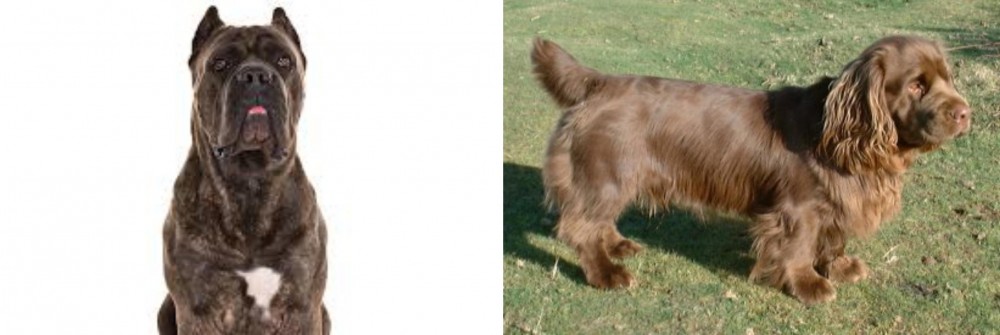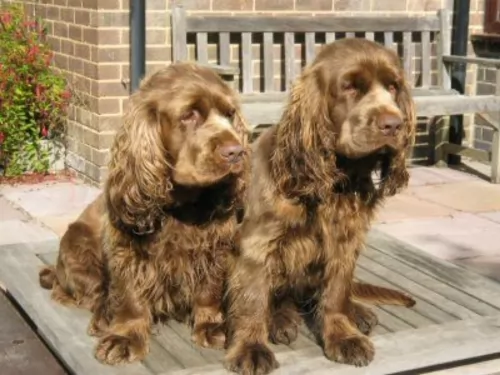 Petzlover
Petzlover Cane Corso is originated from Italy but Sussex Spaniel is originated from United Kingdom. Cane Corso may grow 32 cm / 13 inches higher than Sussex Spaniel. Cane Corso may weigh 30 kg / 67 pounds more than Sussex Spaniel. Cane Corso may live 3 years less than Sussex Spaniel. Both Cane Corso and Sussex Spaniel has almost same litter size. Both Cane Corso and Sussex Spaniel requires Moderate Maintenance.
Cane Corso is originated from Italy but Sussex Spaniel is originated from United Kingdom. Cane Corso may grow 32 cm / 13 inches higher than Sussex Spaniel. Cane Corso may weigh 30 kg / 67 pounds more than Sussex Spaniel. Cane Corso may live 3 years less than Sussex Spaniel. Both Cane Corso and Sussex Spaniel has almost same litter size. Both Cane Corso and Sussex Spaniel requires Moderate Maintenance.
 As a descendant of the Canis pugnax, the Cane Corso dog which hails from Italy has been used for guarding livestock and property. The Corso’s lineage goes far back to ancient Roman times, with the name of dog actually meaning bodyguard dog.
As a descendant of the Canis pugnax, the Cane Corso dog which hails from Italy has been used for guarding livestock and property. The Corso’s lineage goes far back to ancient Roman times, with the name of dog actually meaning bodyguard dog.
As life changed in Italy, the Corso became more rare so that some enthusiasts of the breed began to look at helping the dog recover from the brink of extinction. By 1994, the breed was accepted by the Italian Kennel Club and the dog was also recognized internationally, with the American Kennel Club recognizing the Cane Corso in 2010.
 The Sussex Spaniel comes from Sussex in southern England. The whole purpose of his development was for him to rush between reeds, causing birds to fly up and for their owners to then shoot them so that they could retrieve them.
The Sussex Spaniel comes from Sussex in southern England. The whole purpose of his development was for him to rush between reeds, causing birds to fly up and for their owners to then shoot them so that they could retrieve them.
His history dates back to the 19th century when breeding for the dog started. The first breed standard was also written during this time.
It was about in 1969 that some of these Sussex Spaniels were imported to the United States where they were referred to as a sporting breed. Today they are still a rare breed.
 The Cane Corso is a large dog which hails from Italy. He is a molosser. The dog is muscled and is somewhat less bulkier than other Mastiff breeds. He is 64-70 cm in height and he weighs 45-50 kg.
The Cane Corso is a large dog which hails from Italy. He is a molosser. The dog is muscled and is somewhat less bulkier than other Mastiff breeds. He is 64-70 cm in height and he weighs 45-50 kg.
The head of the Cane Corso is large and the ears are cropped and stand erect. The tail is also traditionally docked to give the dog a distinctive look, but these days, with regulations regarding tail docking, the dog can also be seen with a full tail.
The Corso has a short coat which comes in fawn shades, gray, red, brindle or black shades. White markings are common on the chest, chin, toes and sometimes on the nose.
The Corso is a working dog who needs lots of mental and physical stimulation. He’s an inquisitive dog who is confident and ready to meet life as it comes. He’ll want a strong, firm owner with leadership qualities. He'll require training and socialization and then he becomes an affectionate, obedient pet who gets on well with all members of the family as well as other pets. He is a highly intelligent dog and responds well to training.
 With his low, long body and short legs, this beautiful golden liver color spaniel has long, silky ears and a long, feathery tail.
With his low, long body and short legs, this beautiful golden liver color spaniel has long, silky ears and a long, feathery tail.
He is a moderate shedder. He is quite a distinctive looking dog with his silky coat and sombre expression. You’d descibe him as medium sized dog, standing at between 33 – 38cm in height and weighing 16 -20kg.
The Sussex Spaniel is more slow and sedate than the Cocker Spaniel but he still makes an excellent pet and companion.
He is strong and robust. He is clever too, but slightly stubborn, while also being clownish and entertaining. They’re the kind of dogs who bond strongly with their family and aren’t that enthusiastic with strangers.
They take a while to warm towards people they don’t know. He is steady, reliable and determined and makes a good watchdog. Because he is gentle and even tempered he makes an ideal pet for children and he is able to get on well with other dogs too.
It’s good to have them trained and socialized as they become even more amicable around other people and dogs they don’t know.
 The Cane Corso is known for his agility and athleticism. He is full of energy and he also wants lots of attention and companionship from his human family. With proper training and socialization his temperament changes so that he becomes a super friend and companion while also being protective.
The Cane Corso is known for his agility and athleticism. He is full of energy and he also wants lots of attention and companionship from his human family. With proper training and socialization his temperament changes so that he becomes a super friend and companion while also being protective.
The dog is attentive and receptive to training. The way a dog turns out is essentially what the owners are like, and many Cane Corso dogs have been blamed for being aggressive because they’ve been brought up by aggressive, abusive and irresponsible owners.
The Cane Corso is a large dog with an exuberant nature and who expresses his joy by snorting, wheezing, grunting and slobbering. Treat him well as a family member and you’re going to have a wonderful friend and protector.
 He is a low drooling dog and he adapts easily to life with his human family, preferably in the countryside.
He is a low drooling dog and he adapts easily to life with his human family, preferably in the countryside.
He isn’t the most intelligent breed, but most people love him just like that because he’s eager to please and just wants to be your trusted, loyal pet and companion.
 The life expectancy of the Cane Corso is 10 to 12 years. He is a large, healthy dog breed, but all large dogs are inclined towards bone and joint problems which includes hip dysplasia. Your Cane Corso is also prone to eye defects.
The life expectancy of the Cane Corso is 10 to 12 years. He is a large, healthy dog breed, but all large dogs are inclined towards bone and joint problems which includes hip dysplasia. Your Cane Corso is also prone to eye defects.
Strangely, dogs have 3 eyelids, with the third eyelid being home to tear producing gland. There are some dogs where the ligament fails so that the gland pops out, looking like a cherry stuck at the inner corner of the eye. The veterinarian will be able to perform surgery to attach the gland back.
There are dogs where the eyelids roll inwards. Entropion causes hair to rub on the surface of the eye, resulting in pain and also damage to the cornea. Sometimes surgery will be necessary to fix the eyelid.
 Your Sussex, like any other dog, is going to be prone to some diseases and conditions. If you are going for a puppy, always look for a reputable dog breeder, as this at least gives your dog a better chance of a healthy life.
Your Sussex, like any other dog, is going to be prone to some diseases and conditions. If you are going for a puppy, always look for a reputable dog breeder, as this at least gives your dog a better chance of a healthy life.
This is a congenital heart disease where blood doesn't flow properly and where the right side of the heart works harder and actually enlarges.
If the obstruction is severe, it can cause arrhythmia or congestive heart failure.
If the stenosis is mild, you may not even notice any conditions, but if it's severe, your pet may have difficulty with breathing, his stomach may be distended, and with strenuous exercise he could even collapse.
This is when a disc in the spine ruptures and pushes upward into the spinal cord. It can be an injury or an inherited condition.It is painful and will include anti-inflammatory medications and possibly surgery.
 The short coat sheds fairly heavily twice a year. His coat will certainly need a brush twice a week but during shedding time it will be more often if you want to avoid your home being full of hair. As you brush, its the chance to check for fleas, ticks and skin infections.
The short coat sheds fairly heavily twice a year. His coat will certainly need a brush twice a week but during shedding time it will be more often if you want to avoid your home being full of hair. As you brush, its the chance to check for fleas, ticks and skin infections.
Brush your Cane Corso’s teeth at least 2 or 3 times a week to remove tartar build-up. If you don’t there is the problem of bacteria which can result in gum disease, bad breath and tooth loss.
Your Cane Corso is a large, active dog and will therefore require a high quality food for his breed type. The type of food your dog eats will depend on his age and his activity levels.
The quality of dog food is highly important as it is a contributing factor towards his health. Always try to give your dog some home-made food such as vegetables, rice and meat. Include some raw meat into his diet from time to time as a dog is a carnivore, and raw meat in his diet will help to stave off skin problems. Never forget to check that he has fresh, cool water around the clock.
 Because of the long, silky hair, brushing your Sussex twice a week will be necessary to prevent matting from dirt adhering to the fur.
Because of the long, silky hair, brushing your Sussex twice a week will be necessary to prevent matting from dirt adhering to the fur.
The insides of those long floppy ears can be a breeding spot for bacteria as they don’t easily dry. When you brush him, check inside the ears to make sure they aren't red which could be a sign of ear infection.
Remember, if you don’t like to do all the grooming chores there are, a grooming parlour will do the chores for you. They cut your dog’s hair, check inside his ears, clean his teeth and trim his nails.
Every dog needs excellent food to be healthy. Many people feed their pets the wrong kinds of foods and then wonder why they have to fork up so much on vets fees.
If you feed your Sussex Spaniel one of the commercial manufactured foods, make sure its one of the good ones packed with vitamins and minerals. Tasty home-made food added to his kibble a couple of times a week can do him the world of good if its kept simple – no spicey, exotic foods that can upset the stomach.
Boiled chicken, brown rice or pasta and spinach, sweet potatoes and carrots all chopped up and mixed into the dry kibble once or twice a week will ensure a healthy, happy pet.
To avoid skin allergies and a dull coat, try and add in some raw meat occasionally. Always make sure he has access to fresh, cool water.
These dogs have been accustomed to a life of running in open spaces and they’re going to want lots of exercise. They love ball games and they love a walk in the countryside with lots of new scents to follow.
It’s why this dog isn’t suited to life in a small city property. He needs space and the outdoors to use up his energy.